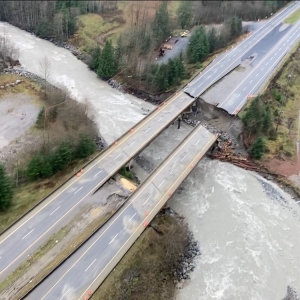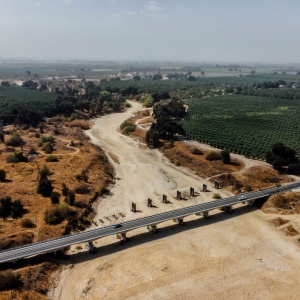Welcome to “What’s Up With Water,” your need-to-know news of the world’s water from Circle of Blue. This is Eileen Wray-McCann.
In western Canada, officials and residents are surveying the damage from a regional flood catastrophe. Powerful storms called atmospheric rivers brought nearly a foot of rain to parts of British Columbia, particularly the province’s southern region. Raging rivers cut critical transportation links, damaging every major rail and highway route that connects coastal Vancouver with towns in the interior. Provincial officials said winter weather will complicate repairs, and it might be months before parts of one key roadway, Highway Five, can reopen. Merritt, a town located along Highway Five, ordered residents to evacuate on November 15 after its wastewater treatment plant flooded. Town officials did not want people in the community without sewage service. The town expected the evacuation order to be in place for a week. The storms in western Canada are another example of weather whiplash, a term used to describe the rapid seesawing from one extreme to another. This summer, the region crackled with a record heatwave and major fires. Lytton, a town located along Highway One, was mostly destroyed by a wildfire in June.
In the Horn of Africa, aid agencies are calling attention to worsening drought that is creating an arc of hunger that extends across Ethiopia, Kenya, and Somalia. Nearly 13 million people in the three countries are grappling with food insecurity that has reached crisis levels – and beyond. That means people are not getting enough calories or they must sell off household assets in order to purchase food. The problem has worsened since the start of the year. The rainy season that typically begins in October has been quiet. If moisture fails to materialize by the end of the year it would be the third consecutive rainy season that is below average. Drought is not the only factor in the hunger crisis. Multiple hazards have brought the region to the brink of a nutrition calamity. One is ethnic conflict. The Ethiopian government is fighting an insurgency in its northern regions that has disrupted food deliveries. Another is insects. Waves of locusts have consumed harvests throughout the region over the last year. The combination of drought, conflict, and swarms has been devastating for households. One herder in northern Kenya told Al Jazeera that half of his livestock have died. He said the other half is too weak to produce milk or be sold on the market.
In the Middle East, a diplomatic breakthrough promises a sharing of water and energy resources. After months of negotiation, Jordan and Israel announced plans to sign a water-for-energy pact. According to Bloomberg news, under the terms of the agreement, Israel will buy solar power from Jordan. In return, Jordan will receive more desalinated water from Israel. The deal is the latest partnership between the two countries, which have a long history of cooperation over water.
In the United States, Pennsylvania regulators advanced a new rule for the state’s drinking water to limit two common PFAS compounds, known as “forever chemicals.” Under the Environmental Quality Board proposal, PFOA would be limited to 14 parts per trillion. PFOS would be limited to 18 parts per trillion. These chemicals are used in many consumer and industrial products including nonstick cookware, water-repellent clothing, and food wrappers. The rule requires the approval of another state agency before it goes into effect. If final approval is granted, Pennsylvania would join a handful of states have established state standards for PFAS chemicals, among them Michigan, New Jersey, and Vermont. The federal government does not currently regulate any PFAS chemicals in drinking water, but the EPA is in the process of writing rules for PFOA and PFOS. A draft version of those rules is expected next year.
And that’s What’s Up With Water from Circle of Blue, which relies more than ever on your support. Right now, your tax-deductible gift goes twice as far, thanks to NewsMatch – a challenge grant matching your one-time or monthly donation dollar for dollar. It’s a limited time offer – so find out more – and make a difference at
circleofblue.org. This is Eileen Wray-McCann – thanks for being here for us.
Editor’s Note: This podcast has been updated to reflect corrections.





